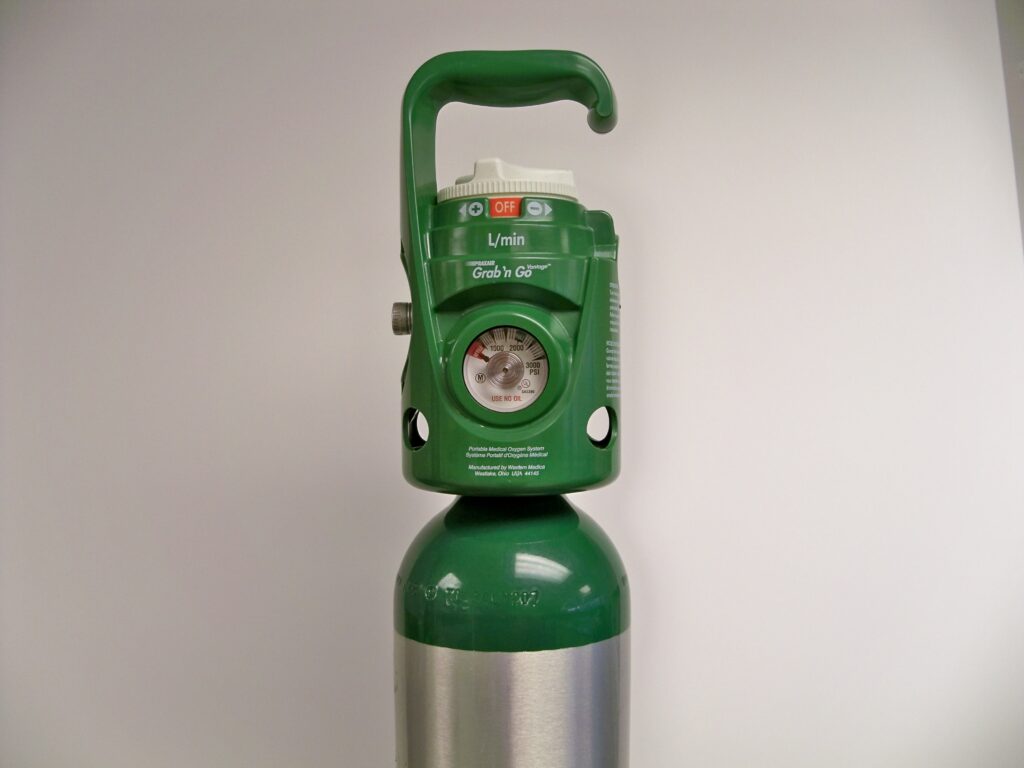A recalled oxygen tank in a 2010 photo. Photo courtesy the U.S. Food and Drug Administration
My sister called me in tears after her first supplemental oxygen delivery. It was July 2013.
At the time, she was a 41-year-old mother to a 4-year-old and a 1-year-old, and worked part-time as an occupational nurse practitioner at the University of Maryland. We have a rare lung disease called primary ciliary dyskinesia (PCD), and because of the resulting lung damage, called bronchiectasis, we were both prescribed supplemental oxygen. My sister needed it 24/7 and I only needed it for exercise.
“Have you received your oxygen yet?” she asked. “I want to warn you. They delivered a home concentrator and a few tanks. I told the driver there weren’t enough tanks to get through work this week and he said, ‘People on oxygen don’t work.’”
When my sister called the supplier to tell them she needed more tanks that week, she was told, “We like to only make one delivery a week.” Yet they had never talked to her to find out what she needed.
I received a call a few days after my sister’s delivery, from a different supplier, saying they wanted to schedule my delivery. When I asked what they were delivering they said a “home concentrator and a few tanks”.
What I didn’t know at the time was that Congress had made a recent change to Medicare law, moving supplemental oxygen into competitive bidding, and this was starting to create problems for all supplemental oxygen users that has now ballooned into an all-out crisis.
Competitive bidding treats oxygen, something we all need to stay alive, like a medical device instead of a medication. The company with the lowest bid becomes a Medicare supplier. The Medicare beneficiary is put into a five-year contract with this company. While the goal was to save money, it resulted in making many oxygen users less active and homebound.
Before competitive bidding, liquid oxygen was a readily available form of oxygen. Liquid oxygen is preferred for people needing high flow, which is 4 liters per minute or more. Most of us have seen those big, compressed gas oxygen tanks that people pull behind them on a two-wheel cart. That tank along with the cart weighs about 15 pounds. By comparison, a liquid oxygen container that delivers the same amount of oxygen for the same amount of time only weighs 5.5 pounds.
The problem is that liquid oxygen is more expensive than compressed gas. This has caused many of the winning bidders to stop carrying liquid oxygen.
In fact, a report published in a 2022 issue of the American Journal of Respiratory and Critical Care Medicine by K. Duan, et. al., states that between 2013 and 2018 there was a 73% decline in supplemental oxygen suppliers and an astounding 89% decline in Medicare beneficiaries receiving liquid oxygen.
The impact is liquid oxygen has been taken away from those who need it the most. Many have become homebound because they can’t manage the heavier tanks. Even those that don’t have high flow needs are being impacted. Companies are only giving them a limited number of tanks a month.
This happened to my mother-in-law in 2014. She lived in California and was very active, picking up her grandchildren after school, going to their all-day soccer games, and taking weekend trips with her family. This all stopped when her oxygen company would only give her 20 small tanks a month. She went through 10 tanks in one week when we were out visiting.
Similarly, my brother-in-law had to plead with my sister’s supplier for an extra tank so she could go out with the family for Mother’s Day.
Maryland’s lawmakers in Congress have the opportunity to fix this problem. The Supplemental Oxygen Access Reform (SOAR) bill (S. 3821 and H.R. 7829) was introduced with bipartisan support earlier this year. This bill has the support of over 30 patient advocacy and professional groups, including the American Lung Association and Running On Air. We are asking all members of Congress to become cosponsors of this bill.
You can help with this effort by calling your members of Congress now and ask them to cosponsor these bills. Because those of us on oxygen don’t just want enough oxygen to keep us alive, we deserve enough oxygen so we can thrive.

